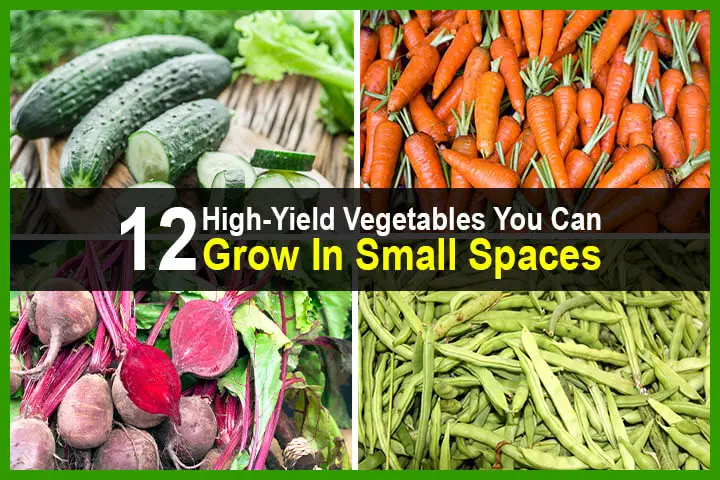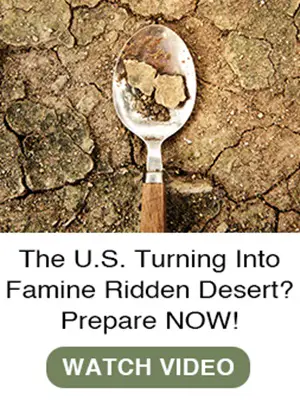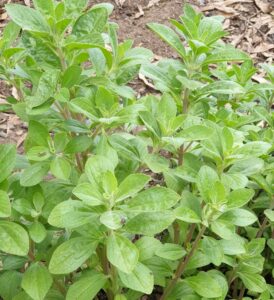Estimated reading time: 10 minutes
Many books and articles about growing your own food assume you have a large yard with plenty of room. But what if you live in an apartment or small home with only a patio or balcony to satisfy your green thumb?
The good news is that you can grow vegetables successfully even in the smallest of spaces. You just have to choose the right kinds. This article offers guidance on high-yield plants you can grow in small spaces.
Want to save this post for later? Click Here to Pin It On Pinterest!
1. Tomatoes

Although many tomato varieties require lots of room to grow, there are plenty of options for small spaces. One we like is the Sweetheart of the Patio Tomato. You can grow this sweet cherry tomato variety in a container or a hanging basket.
If you like your tomatoes big and meaty, a good option for a small space is the BushSteak Tomato. The tomatoes are hefty, but the plant itself is compact – only 20 to 24 inches in height. This article offers more information on growing tomatoes in a small garden area.
2. Peppers

We like Sweet Golden Baby Belle Peppers, which are ideal for containers and pack a sweet flavor. Check out this video for using a vertical tower for growing 30 peppers in two feet of space.
For more tips on raising pepper plants in small spaces, watch this video. Hot peppers also do well in containers. You can learn more here.
3. Cucumbers

Your best bet is to look for bush varieties if you lack space. Keep in mind that a bush vegetable variety does not mean the fruit is small, just the size of the plant itself. Or consider the Spacemaster Cucumber, which is perfect for a patio or balcony.
You can enjoy these cucumbers in summer salads, or they make great pickles. Trellises work well for cucumbers. Learn more about growing cucumbers vertically here.
4. Carrots

Carrots are one of the easiest vegetables to grow in containers. You’ll want to try some of the smaller and early varieties, such as Early Nantes and Caracas Hybrid carrots. These are both short-rooted and produce slim vegetables, allowing you to get a lot of bang for your buck.
Also good for containers are the Chantenay varieties. Carrots do well with companion planting, along with peas, onions, and lettuce. Here are tips for growing carrots in containers.
5. Peas

Peas can thrive in containers and small gardens because they don’t have deep roots. The Tom Thumb Dwarf variety is an excellent producer. We also like sugar snap peas and snow peas. Read this article for details on growing peas in containers in your small space.
6. Leafy Greens

I like growing lettuce and other leafy greens on a patio and balcony because the neighborhood wildlife is less likely to get to it before I do! Try the Tom Thumb variety, which matures at only about five inches. Here’s a beginner’s guide for growing lettuce in small spaces.
7. Radishes

The fast and easy-to-grow vegetables are perfect for container gardening. If you’ve got kids, choose a see-through container that lets young gardeners watch the below-ground growth.
Two varieties we like are the fast-growing Cherry Belle and French Breakfast. This How to Grow Radish in Containers video takes you from seed to harvest.
8. Pole Bean

Many vining plants work well in small spaces because they grow up, not out. Pole beans are one of the best choices for a high yield. An ideal container for pole beans is two to three feet long and at least 10 inches wide.
Use a trellis, mesh fence, or other ladder-type or tepee structure for the vines to support themselves. This video shows you how to grow various types of beans in small spaces.
9. Green Onions

Green onions (or scallions) are another excellent small-space option because they do not need much depth. You also can harvest them at just about any stage you like – young ones are tasty when eaten as microgreens.
Try the Long White Bunching or the Evergreen Bunching Nebuka varieties. Here is more information on growing green onions in small gardens or even indoors.
10. Kale

Kale is a nutritious vegetable that also adds color and texture to the look of your small garden. It does need some room for healthy growth, but kale will grow well in a well-drained container that is 18 inches across and at least 10 inches deep.
Check out this video, aptly named How to Grow a Ton of Kale in a Small Space, for some amazing results.
11. Herbs

Fresh herbs are fantastic to have on hand for cooking and seasoning your meals, and they don’t take up much room. Another plus is that you can grow several herbs together in one container.
Most herbs have shallow root systems that need only about six inches of depth. However, if you’re growing cilantro, parsley, or dill in your herb garden, it’s best to use a container that is at least 12 inches deep and 12 inches wide to accommodate their more extensive taproots.
Also, check the seed packet before planting herbs together. For example, rosemary doesn’t need frequent watering, but parsley does. Here are helpful suggestions for small-space herb gardening.
12. Beets

Yes, you can grow beets on your patio. And while you’re waiting for the beets to grow, you can use the tasty greens for your salads. Here’s how to grow beets in buckets. And this one demonstrates the process in vertical containers that work well on a balcony or deck.
Tips for Getting the Best Yield From a Small Space

Now that you know some veggies to grow in your small garden area, here is an overview of tried and true ways of getting an abundant harvest.
Find the right location
Vegetables need sunlight to grow. If your deck or patio gets less than six hours of direct sunlight each day, you may need to supplement with artificial light.
Consider drainage
Make sure your containers or the soil, if you’re planting in the ground, drains well. Plant roots systems can be damaged by too wet conditions.
Maintain soil quality
Use quality potting mix soil to plant your seeds, and keep in mind that you may need to add compost or other organic matter to continue providing the best nutrients for your plants as they grow. To determine the soil’s pH level and nutrient content, you can use a soil testing kit or bring a sample to your local extension service for testing.
Consider compact varieties of vegetables
Many of your favorite veggies come in compact varieties. Check out seed catalogs and websites for ideas.
Grow up, not out when possible
Vertical gardening is a great way to maximize your space. Use trellises, stakes, fences, poles, pallets, and walls to train your plants to grow up. And you can also “grow down” with hanging baskets filled with herbs, cherry tomatoes, or strawberries.
Get creative with space
Consider planting in circles or squares instead of the traditional rows to maximize your room. Another idea is to plant taller veggies in the back of a raised bed (like tomatoes and peppers), with shorter ones (like radishes and lettuces) in the front. Using raised beds allows you more garden space.
Try succession planting
Succession planting – or planting different vegetables at different times – can boost your harvest. For instance, you can grow lettuce in the spring, tomatoes in the summer, and kale in the fall in the same garden space.
Learn about companion planting
Some plants benefit each other by being near each other. For example, Native Americans traditionally planted beans with squash and corn to reduce pests and improve soil nutrients.
Keep an eye out for pests and diseases
Remove infected leaves promptly to prevent any disease from spreading. Research natural methods of pest control.
Water with care
Water the base of the plants rather than their leaves and water in the morning to prepare plants for the heat of the day. Overwatering can be just as harmful as underwatering. Use your index finger to check soil moisture below the surface, or use a moisture meter.
Like this post? Don’t Forget to Pin It On Pinterest!

















